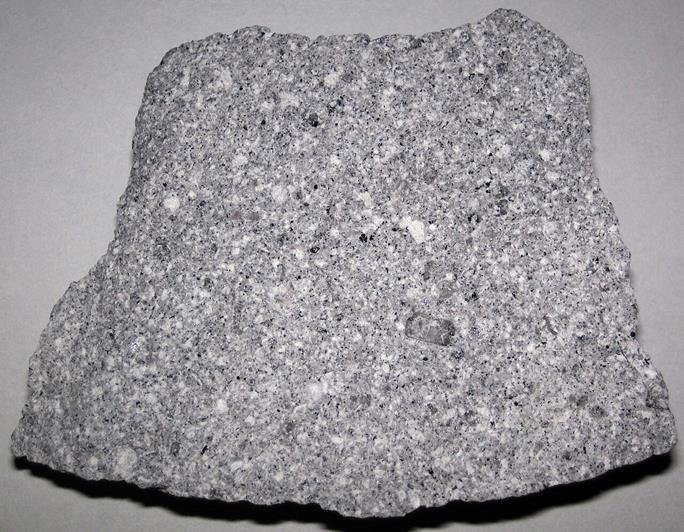Dacite is a fine-grained, light-colored volcanic rock with a felsic composition. Felsic rocks are silica-rich and dominated by light-colored elements like silicon, oxygen, aluminum, sodium, and potassium.
On the other hand, volcanic rocks form when lava solidifies near or on the Earth’s crust. Cooling is fast on the earth’s surface. This causes volcanic rocks to form a fine-grained texture. However, it can also have other textures.
Dacite rock is composed of andesite and rhyolite. However, it differs from rhyolite because it has mainly oligoclase and plagioclase phenocrysts, while rhoulite has alkali feldspar phenocrysts like sanidine or orthoclase.
Lastly, Guido Stache, an Austrian geologist, named this rock after Dacia. Dacia is a former Roman Empire province and is this rock’s type locality.

Description and Appearance
Dacite is a massive, hard, fine-grained, light-colored rock with 2.3-2.7 g/cm3 (non-vesiculated type) and a Mohs hardness scale of 6 to 7.
Its color is off-white, gray, pinkish, or blue-gray, with few having yellow, brown, or reddish and rarely black. The typical color index M is less than 20, making it a leucocratic rock.
Dacite texture is fine-grained, but some can show other fabrics or textures like porphyritic and flow banding, with some vesicular.
Vesicular dacite has voids or cavities created when exsolved, and escaping bubbles are trapped by solidifying lava. These vesicles are sometimes filled with secondary minerals forming amygdules or amygdaloidal fabric.
On the other hand, porphyritic dacite has large, well-formed crystals or phenocrysts plagioclase (oligoclase, rarely sanidine), and sometimes, pyroxenes, apatite, hornblende, and Fe-Ti in a fine-grained matrix of these and a few other minerals.
Lastly, some young dacites may have flow bands or foliations that differ in crystallinity of vesicle density. These layers can be cm to less than a mm scale.
Chemical composition
Dacite is an acidic rock with 63-69 wt. % silica. It is high in sodium and aluminum oxides and relatively lower in iron and magnesium oxides.
Mineral composition
Dacite is a felsic rock primarily made of plagioclase feldspar and quartz or tridymite. Also, it may have considerable alkali feldspar and minor hornblende, biotite, pyroxene, olivine, or glass.
Accessory minerals are magnetite, sphene, apatite, zircon, ilmenite, and rarely garnet.
Plagioclase is oligoclase, sanidine, or labradorite, while alkali feldspar is sanidine and tends to be higher in dacites whose composition tends to rhyolite.
Quartz or tridymite are, on the other hand, interstitial or can occur as phenocrysts in the porphyritic varieties.
On the QAPF classification, dacite is a volcanic rock in which quartz is 20-60% of the total QAPF content by volume, and plagioclase accounts for at least 65% of the total feldspars.
On the TAS or Total Alkali-Silica classification, dacite has more than 63% silica, and combined alkalis (Na2O + K2O) are up to 8%.
Considering mineral and chemical composition, dacite is the extrusive equivalent of granodiorite, a plutonic or intrusive igneous rock.
How does dacite form?
Dacite forms when silicic magma erupts, quickly cools, and solidifies on the Earth’s surface or in shallow sills, dikes, and other intrusions.
The quick cooling results cause rapid nucleation, forming a fine-grained or aphanitic texture. If the magma is quenched too quickly, it will form obsidian glass, and if the magma is high in gases or volatiles, it will form dacitic pumice.
Dacitic magma forms from the fractional crystallization of a large volume of mantle-derived magma or when subcrustal rocks partially melt. This can happen with or without contamination by subcrustal rocks.
Also, rhyolite and andesite magma mixing can form dacitic magma.
This magma can erupt effusively if low in gases, forming blocky lava flows, domes, plugs, and sometimes pillow lava.
It will erupt explosively if it is high in volatiles or interacts with water. Eruption styles range from less violent Vulcanian to moderately violent Peléan to catastrophic Plinian eruptions. These eruptions will eject pyroclasts like ash, lapilli, volcanic blocks, or bombs.
Violent eruptions may cause pyroclastic surges or flows that will deposit dacitic ignimbrites, some very extension.
Some eruptions may be effusive and explosive, with some stratovolcanoes known to erupt dacite.
Where is dacite found?
Dacite rocks are most common on continental volcanic margins above long-lasting subduction zones and where the continental crust is thick. Also, it is relatively common in mature island arcs.
Smaller amounts can occur in other tectonic settings like mid-ocean ridges, back-arc basins, intracontinental settings, some large igneous provinces, and continental rifts.
Some places with considerable dacite rocks include the Cascade Range in Canada and the USA and the central Andes in South America.
Lastly, island arcs with dacite include Antilles, Aleutian, Fiji Islands, Japan, Sundra, and Tonga–Kermadec.
Dacite uses
Dacite rock makes aggregate and dimensional stones and can host valuable metal sulfides and other ores.
Crushed to make aggregate for roading, railroad ballast, subbases, fills, etc. Also, you can use its gravel on your unpaved walkways, patios, or driveways.
In the dimensional stone industry, cut and polished dacite is used to build houses and monuments or make pavers, sculptures, etc.
Some porphyritic dacite to trachyandesites known as red, purple, or Roman Imperial Porphyry from Mons Porphyrites in Egypt were quite popular during the antiquity age among the Romans and Byzantines as dimension and sculpture rocks.
Dacitic pumice has uses in landscaping, horticulture, lightweight aggregate, abrasive cleaners, and beauty and personal care.
Lastly, some dacitic rock rocks valuable deposits of ores like copper, zinc, lead, silver, etc. Examples are the Iberian pyrite belt in Portugal and Spain and the Japanese Kuroko belt. Others are Slovakian Ore and Vihorlat Mountains and Romanian Transylvanian Ore Mountains.
Frequently Asked Questions (FAQs)
It is a porphyritic dacite rock with large, well-formed crystals or phenocrysts of sanidine. It is composed of dacite and rhyolite.
They fall into sub-alkaline, which is categorized either into calc-alkaline or tholeiitic. They can be classified according to potassium content and give low, medium, and high potassium.
